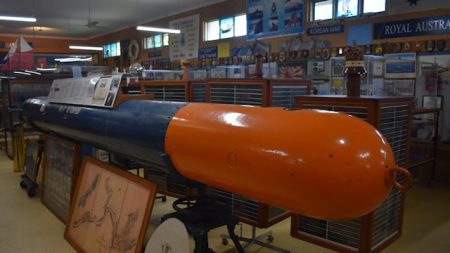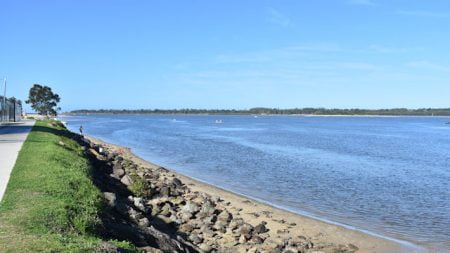The Ballina Naval & Maritime Museum has a collection and displays of maritime and naval history and memorabilia.
Ballina has a long history of shipping on the river, beginning with the arrival of Sally in 1842. By 1847, Ballina had four regular trading vessels bring in supplies and passengers and taking out timber. Ballina was the 3rd busiest port in NSW after Sydney and Newcastle, shipping out timber, dairy, sugar, horses, pigs, and canned goods.
Ballina became a centre for shipbuilding and ship repairs over a range of vessels, including whale chasers, island traders, ferries, pleasure boats, large ocean going tugs, and naval patrol boats. Ballina is still the largest non-metropolitan sub branch of the Naval Association of Australia.
The dominant exhibit when you first enter the museum is one of the three rafts from the Las Balsa Expedition, a journey from Ecuador to Ballina in Australia in 1973.
The crossing is the longest known raft voyage and the only multi-raft crossing of the Pacific Ocean. The three rafts were called Aztlan, Guayaquil, and Mooloolaba, the latter being the intended arrival location in Australia.
The only surviving raft, the Aztlan, is the one on display in the Ballina Naval & Maritime Museum.
In a room behind the Aztlan is a ship that has been cut across showing the cross-section of the hull so you can see its build structure, the front and back halves separated. Stairs lead up to the deck of the front half with a helm wheel.
Between the two halves is a series of block and tackle ropes to demonstrate the lifting effort required with increasing number of pulleys. Interactive displays are great when taking children with you to museums.
The largest portion of displays are models of maritime vessels, ranging from local river boats and tugs, Royal Australian Navy and other navy vessels, merchant navy, and local shipping.
Australian Navy models include HMAS Melbourne, HMAS Canberra, and a Cato Class submarine. The Australian Navy first started from colony navies for Queensland and Victoria, with NSW considered to not need as it was protected by the Royal Australian Navy Squadron based in Sydney. An early naval model is of Her Majesty’s Queensland Ship HMQS Paluma.

Another prominent display is a torpedo, a British 21-inch Mk9 torpedo as used in World War II on Tribal, Battle, and Darling Class destroyers. The torpedo runs on compressed air stored at 3,100lbs per square inch and a burner cycle radial engine or semi-diesel to propel it. Carrying 1,000lbs of AMATOL explosives, the torpedo detonates the warhead when it makes contact with its target.
There are many models of ships and ocean liners, so many vessels you will no doubt have more than you can spend time looking at in detail. One that stood out to be was the Freshwater, a ferry from Sydney that I had boarded many times going between Sydney Quay and Manly.

The museum sits between the Ballina Visitor Information Centre and the Richmond River with some green space between it and the river. There are a couple of picnic tables beside the river. A pathway goes along the river bank and on the day we were there a few people were fishing from the banks.
The museum has a lot to look at, especially if you like to look at the countless models they have. The Aztlan was my favourite part of the displays, being such a unique item that you know can never be found elsewhere.
To get there

From the motorway, take the Bruxner Hwy exit to Ballina and follow the signs towards Ballina at the roundabout onto River St. Follow River St for 4.8km and turn right into Las Balsas Plaza at the brown sign for Maritime Museum and the Ballina Visitor Information Centre. This leads into the parking area with the museum next to the parking behind the information centre.


